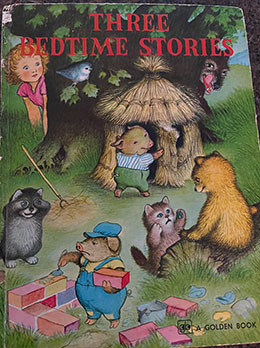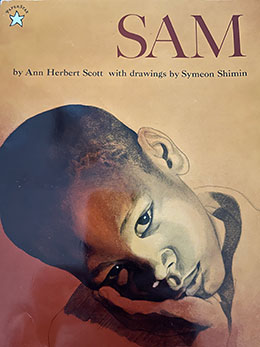
 As a child, I was shy and scared — of other kids, dogs, almost anything outside my fence. My parents enrolled me in preschool, hoping I’d blossom. I refused to get out of the car. I had everything I needed at home, including a mom who loved reading to me. My first book memory is Three Bedtime Stories: The Three Little Kittens, The Three Little Pigs, The Three Bears, illustrated by Garth Williams. Even today, when I page through this book, I’m scrunched up on my childhood couch with my mom and my sisters. It’s emotional time travel to my warmest memories — despite lines like: Then the big bad wolf huffed and he puffed, and he blew the house in. He ate up the fat little pig. And that was the end of the first little pig. For some reason, that didn’t scare me.
As a child, I was shy and scared — of other kids, dogs, almost anything outside my fence. My parents enrolled me in preschool, hoping I’d blossom. I refused to get out of the car. I had everything I needed at home, including a mom who loved reading to me. My first book memory is Three Bedtime Stories: The Three Little Kittens, The Three Little Pigs, The Three Bears, illustrated by Garth Williams. Even today, when I page through this book, I’m scrunched up on my childhood couch with my mom and my sisters. It’s emotional time travel to my warmest memories — despite lines like: Then the big bad wolf huffed and he puffed, and he blew the house in. He ate up the fat little pig. And that was the end of the first little pig. For some reason, that didn’t scare me.
As you’d imagine, I had a rocky start in school. But I loved the library. I’d hide in a corner with a book, and everything else would fade. Once, I didn’t notice my class had lined up and left. I was with my “safe” friends — the characters in my favorite books. I loved the Frances series by Russell Hoban, illustrated by Lillian Hoban. Frances wasn’t afraid to speak up, she made up the best rhymes, and she found sly ways to delay bedtime. In a strange way, Bedtime for Frances was my first experience of the intersection of grief and laughter. My mom read us the book one summer night, when we were living in a camper by a lake. Later that night, my grandpa suddenly died. The next morning, on the drive to my grandparents’ farm, one of my sisters and I replayed our favorite lines from the book:
“There is a tiger in my room,” said Frances.
“Did he bite you?” said Father.
“No,” said Frances.
“Did he scratch you?” said Mother.
“No,” said Frances.
“Then he is a friendly tiger,” said Father.
Hilarious! Did the parents really believe there was a tiger in the room? In the middle of the sadness my sister and I got the giggles. It felt wrong — but also so good.

Frances also showed me girl-power. In Best Friends for Frances, when Albert says his ball game is a “no-girls game,” Frances creates a no-boys picnic to teach him a lesson. Of course, Albert begs to join in.
“Well, I’m not sure,” said Frances. “Maybe you’ll be best friends when it is goodies-in-the-hamper time, but how about when it is no-girls-baseball time?”
Frances was no pushover.
While Frances was aspirational, Betsy (from Carolyn Haywood’s Betsy series) was a kindred spirit. This line from B is for Betsy expressed my feelings exactly:
She thought of Mother who was getting farther and farther away every moment. “If I got up now and ran out the door,” thought Betsy. “I could catch Mother. I could be out in the sunshine again with Mother and take hold of her hand. I could tell Mother that I don’t want to go to school, that I know it is a terrible place…
There! I wasn’t the only one! Of course, Betsy learns to like school in the first few chapters. It took me much longer; still, the book gave me hope.
Given my timidity, I often needed little pep talks. For this, I had The Little Engine that Could by Watty Piper, illustrated by George and Doris Hauman. I loved the hesitant but ultimately determined Little Blue Engine (and she was my favorite color!) My heart beat a little faster as the tiny engine tugged and pulled and pulled and tugged, and I chanted along as she puffed I think I can — I think I can — I think I can… Of all my childhood books, this is the most worn. Apparently, I needed it often.
 Another childhood favorite was Sam by Ann Herbert Scott, illustrated by Symeon Shimin. I loved the soft illustrations and the expressive face of main character Sam, who goes from room to room asking his parents and older siblings to play. Sam gets sadder and sadder as everyone pushes him away. Finally, he drops to the floor, crying. The whole family gathers around, comforting and encouraging him as he rolls out dough for a tart.
Another childhood favorite was Sam by Ann Herbert Scott, illustrated by Symeon Shimin. I loved the soft illustrations and the expressive face of main character Sam, who goes from room to room asking his parents and older siblings to play. Sam gets sadder and sadder as everyone pushes him away. Finally, he drops to the floor, crying. The whole family gathers around, comforting and encouraging him as he rolls out dough for a tart.
“Say, that’s a good job for Sam,” said his father.
“He’s not too little,” said his sister.
“And he’s not too big,” said his brother.
It’s a book about a typical, loving family (albeit with the traditional gender roles of its time). But it was one of the few books I’d seen with characters of color. Here was a family of real, imperfect people who loved each other deeply, a lot like mine. This book felt important. And it was.
I also was drawn to books about orphans. My favorite (even more than The Boxcar Children) was James and the Giant Peach by Roald Dahl. It starts with my worst nightmare — losing both my parents.
Then, one day, James’s mother and father went to London to do some shopping, and there a terrible thing happened. Both of them suddenly got eaten up (in full daylight, mind you, and on a crowded street) by an enormous angry rhinoceros which had escaped from the London Zoo…
Luckily, my parents never went to London. Plus, James’ evil guardians Aunt Sponge and Aunt Spiker are as hilarious as they are scary. My favorite childhood poem comes from them:
“I look and smell,” Aunt Sponge declared, “as lovely as a rose!
Just feast your eyes upon my face, observe my
shapely nose!
Behold my heavenly silky locks!
And if I take off both my socks
You’ll see my dainty toes.”
“But don’t forget,” Aunt Spiker cried, “how much
your tummy shows!”
The worst thing in the world happens to James. But he prevails. He climbs into the giant peach; discovers a bunch of oversized, talking insects; and they all roll off on a grand adventure, crushing the two aunts as flat and thin and lifeless as a couple of paper dolls cut out of a picture book. Dark, but so satisfying.
I hesitate to include the next book because it’s in a whole different category (though it, too, contains both darkness and light, tragedy, inspiration, and even girl-power.) I remember the first time I read the Holy Bible on my own. I was 12 years old, flopped on my grandma’s bed, looking for something to do. I’d challenge myself — see how much I could read! I don’t remember what I read. I just remember feeling proud.
I still read the Bible—though not as fast. I don’t always get it. I puzzle over the seeming contradictions, wonder about the historical context, hold onto the parts that speak to me and challenge me the most. Like this one:
And what does the Lord require of you?
To act justly and to love mercy
And to walk humbly with your God.
My favorite books — the ones I read as a child and the ones I’m reading now — are part of me. They inspire and inform my writing — the perfect start to Because of Winn Dixie by the masterful Kate DiCamillo. They make me cry — the scene in Send For Me by Lauren Fox, where the grandmother clings to her 2‑year-old granddaughter who is fleeing WWII Germany with her parents. They make me laugh — the entire cast of quirky characters from Fredrik Backman’s Anxious People.
And all of them — the many books over the many years — make me think and make me feel. For that, I am grateful.

What a great list of books, Catherine! I was a big “Betsy” fan as well when I was in elementary school, and James and the Giant Peach was a story I always read to my fourth graders when I was a teacher. Thank you for the happy memories.
I love your description of these books and how they fit your life. Can’t tell you how pleased I was to also see Anxious People on your list! I adore that book (and basically everything written by Fredrik Backman).
Must be awesome to recall such wonderful memories and thanks for sharing them with everyone. You are a true blessing to the young that you have influenced and the ancient, that you have befriended!